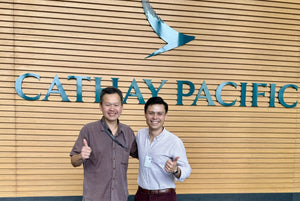The cellar in the sky is big business, and this may be something you have barely considered! That particular New Zealand Sauvignon Blanc you sip enroute to Bali is not there by coincidence. It has gone through a long vetting process to achieve that lucrative listing – by wine professionals.
The cellar in the sky can also be a high-profile business. Consider, says Michael Hill Smith MW, the wine lists of all the first class cabins of all the world’s airlines: that’s a significant, premium market. In many of these you will see the exact same prestige grandes marques Champagne labels. A listing in this cabin (or even Business) elevates you to luxury, sought-after status, just like that.
A wine producer and consultant in Adelaide, Hill Smith is a veteran in the business, having worked with Singapore Airlines for more than two decades. He is part of a small committee, alongside Hong Kong-based Jeannie Cho Lee MW, which meets twice a year to help the airline select listings such as aged Bordeaux for First Class, and white Burgundy for Business Class. And for Economy? “Something which is a nice glass of wine!” he says.
Cathay Pacific similarly has a small team focused on bringing quality wine to every cabin, headed by the airline’s Wine, Spirits and Beverages Manager, Ronald Khoo, accompanied by Debra Meiburg MW, who lives in Hong Kong and has consulted to the airline for nearly 20 years. These teams are necessary because, as Khoo explains, due to low cabin humidity “we can’t smell as sensitively as when on the ground”. Thus wine choices have to be quite specific. “We tend to look for wines which are more fruit forward, have higher fruit definition, and less oak and tannin”. Meiburg explains: “Often wines that are clearly the best on the ground come near last after a trip through the air. They show fatigue as if they have been recently bottled”. Cho Lee says that one of the most interesting aspects of this consultancy is understanding what really causes wine to change on the plane; while her top choice while flying is Champagne.
Hill Smith additionally highlights the problem of temperature control in the cabin, whereby a bottle of wine does not come straight from the Eurocave, and it may also have been agitated! “The wine has to work really hard,” he laughs.
The wine industry as a whole is embracing aspects of sustainability, such as working with lighter bottles or alternative packaging and formats, but airlines have to face various trade-offs. For now, says Khoo, Cathay Pacific is not looking at boxed or canned wine, as the quality of the wine is the most important factor. They change listings on a 3 or 6-month rotation, depending on category, but “it is the wine style and quality that we always focus on first”. While Hill Smith believes that, with developing technologies, there is potential for canned wine and single-pour PET (plastic) packaging, he and Khoo agree that the best format in the air, at least for now, remains the good old 750ml glass bottle.
But perhaps the enjoyment compromise is diminishing. Hill Smith comments that the new, more modern wave of planes come with higher relative cabin humidity. He comments that Chef Neil Perry (of Rockpool fame), who has long worked alongside Qantas Airlines, says that his food in the air is now tasting (even) better!
WORDS: ANNABEL JACKSON

